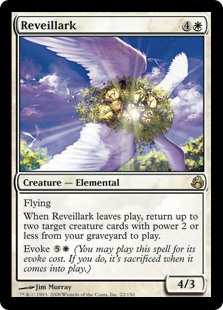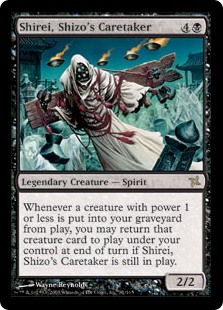It’s that time again. This week on Intellectual Offering we are going back to IO's roots and examining a deck on a card-for-card basis. Ok, that’s a small lie. This week we examine a couple of decks that are all actually one. This week I’m looking at Tymna the WeaverTymna the Weaver and Sidar Kondo of JamuraaSidar Kondo of Jamuraa, two legendary creatures that are fantastic together because they both don’t have commas in their names. That, and the synergy between the two is pretty high; Sidar granting all our smaller creatures unblockability means that we get more options to draw more cards off of Tymna, which in turn fuels further beatdowns. I think these two are underrated commanders so I’ve decided to take a look at the various ways people are using them in the hopes of sparking some fun discussion.
Swing Your Partner Round 'n Round

Let’s start by taking a look at the average Sidar and Tymna deck:
Commadners (2)
- 1 Sidar Kondo of JamuraaSidar Kondo of Jamuraa
- 1 Tymna the WeaverTymna the Weaver
Creatures (33)
- 1 Acidic SlimeAcidic Slime
- 1 Avacyn's PilgrimAvacyn's Pilgrim
- 1 Aven MindcensorAven Mindcensor
- 1 Birds of ParadiseBirds of Paradise
- 1 Deathrite ShamanDeathrite Shaman
- 1 Elves of Deep ShadowElves of Deep Shadow
- 1 Elvish MysticElvish Mystic
- 1 Eternal WitnessEternal Witness
- 1 Fauna ShamanFauna Shaman
- 1 Fyndhorn ElvesFyndhorn Elves
- 1 Gaddock TeegGaddock Teeg
- 1 Grand AbolisherGrand Abolisher
- 1 Hushwing GryffHushwing Gryff
- 1 Kambal, Consul of AllocationKambal, Consul of Allocation
- 1 Karmic GuideKarmic Guide
- 1 Kataki, War's WageKataki, War's Wage
- 1 Llanowar ElvesLlanowar Elves
- 1 ManglehornManglehorn
- 1 Mentor of the MeekMentor of the Meek
- 1 Mirror EntityMirror Entity
- 1 Mother of RunesMother of Runes
- 1 Ramunap ExcavatorRamunap Excavator
- 1 Reclamation SageReclamation Sage
- 1 Recruiter of the GuardRecruiter of the Guard
- 1 ReveillarkReveillark
- 1 Sakura-Tribe ElderSakura-Tribe Elder
- 1 Scavenging OozeScavenging Ooze
- 1 Selfless SpiritSelfless Spirit
- 1 SpawnwritheSpawnwrithe
- 1 Sun TitanSun Titan
- 1 Thalia, Guardian of ThrabenThalia, Guardian of Thraben
- 1 Viscera SeerViscera Seer
- 1 Zulaport CutthroatZulaport Cutthroat
Instants (6)
- 1 Anguished UnmakingAnguished Unmaking
- 1 Beast WithinBeast Within
- 1 Path to ExilePath to Exile
- 1 Swords to PlowsharesSwords to Plowshares
- 1 Vampiric TutorVampiric Tutor
- 1 Worldly TutorWorldly Tutor
Sorceries (7)
- 1 CultivateCultivate
- 1 Demonic TutorDemonic Tutor
- 1 Dawn // DuskDawn // Dusk
- 1 Green Sun's ZenithGreen Sun's Zenith
- 1 Immortal ServitudeImmortal Servitude
- 1 Kodama's ReachKodama's Reach
- 1 Merciless EvictionMerciless Eviction
Artifacts (7)
- 1 Golgari SignetGolgari Signet
- 1 Lifecrafter's BestiaryLifecrafter's Bestiary
- 1 Lightning GreavesLightning Greaves
- 1 MeekstoneMeekstone
- 1 Selesnya SignetSelesnya Signet
- 1 SkullclampSkullclamp
- 1 Sol RingSol Ring
Enchantments (7)
- 1 Aura ShardsAura Shards
- 1 Blind ObedienceBlind Obedience
- 1 Bower PassageBower Passage
- 1 Phyrexian ArenaPhyrexian Arena
- 1 Phyrexian ReclamationPhyrexian Reclamation
- 1 Sylvan LibrarySylvan Library
- 1 True ConvictionTrue Conviction
Planeswalkers (1)
- 1 Elspeth, Sun's ChampionElspeth, Sun's Champion
Lands (38)
- 1 Bloodstained MireBloodstained Mire
- 1 Bojuka BogBojuka Bog
- 1 Canopy VistaCanopy Vista
- 1 Caves of KoilosCaves of Koilos
- 1 Command TowerCommand Tower
- 1 Godless ShrineGodless Shrine
- 1 Isolated ChapelIsolated Chapel
- 1 Llanowar WastesLlanowar Wastes
- 1 Marsh FlatsMarsh Flats
- 1 Murmuring BoskMurmuring Bosk
- 1 Overgrown TombOvergrown Tomb
- 1 Path of AncestryPath of Ancestry
- 1 Reliquary TowerReliquary Tower
- 1 Sandsteppe CitadelSandsteppe Citadel
- 1 Sunpetal GroveSunpetal Grove
- 1 Temple GardenTemple Garden
- 1 Urborg, Tomb of YawgmothUrborg, Tomb of Yawgmoth
- 1 Verdant CatacombsVerdant Catacombs
- 1 Windswept HeathWindswept Heath
- 1 Woodland CemeteryWoodland Cemetery
- 8 PlainsPlains
- 4 SwampSwamp
- 6 ForestForest
This isn’t something that we’ve done before in this series, so I’d like to take just a second to dive into what an average decklist actually means in terms of EDHREC. For this all I’ve done is click the option under the image of the commander “View average deck”. This generates a list based of the 100 most commonly played cards (commander(s) included) in the deck. This may seem intuitive, but it’s important to note that what this doesn’t do well is catch things that are commonly played, but exclusive to a certain build of the deck. This is more obvious if you were to try and take a commander like Atraxa, Praetors’ VoiceAtraxa, Praetors’ Voice and get an average list out of her, there would be cards for planeswalker-based superfriends decks right alongside things for +1/+1 counter theme decks. This issue will become relevant later on in the article, for now let’s just assume there’s no overlapping strategies in this list and use it as our baseline for commentary.

Right away there are things worth noting. Players are clearly attempting to maximize on Sidar’s ability to grant unblockability, with only a couple of very powerful inclusions above the 2 power mark: Sun TitanSun Titan and ReveillarkReveillark. The deck also plays around the theme in other ways, including powerhouses like Immortal ServitudeImmortal Servitude and Dawn // DuskDawn // Dusk to reanimate mass amounts of hatebears without the drawbacks of other mass-reanimation spells like Living DeathLiving Death that can also help opponents. The deck has a very minor sacrifice theme, and plays only Zulaport CutthroatZulaport Cutthroat, which I do find strange given that both Blood ArtistBlood Artist and Falkenrath NobleFalkenrath Noble fall in the deck’s intended strategy. Artist just misses the cutoff for average inclusion at 21% but Noble lags behind wildly with only 5% inclusion rate, which seems like a strange disparity to me. While the Artist wouldn’t do much in the way of combat, it would also help punish Wrath of GodWrath of God effects that are generally devastating to aggressive strategies like this one. The average player is also missing out on some powerful redundancy in the form of Bygone BishopBygone Bishop, which misses the cut at only 18% inclusion. I personally find Bishop to be better than Mentor of the MeekMentor of the Meek (which has 46% inclusion rate) as it lets you pay for cards in installments rather than all at once. The argument that you miss out on some triggers as it needs to be cast (versus enters the battlefield) and that Bishop checks CMC versus power is nonsense to me as only 4/35 creatures in the average deck have CMC > 3. Additionally I am surprised by the complete lack of creature-based creature removal in the above list. That means that the average player is relying on exactly four instants to deal with the majority of creature-based issues. In a deck that is so heavily themed on creatures I would expect to at least see something like a NekrataalNekrataal at the very least.

Since this deck likes playing small creatures, the obvious path for this is finding hatebears that can set our opponents back while not affecting our plans. The average deck includes a great number of such creatures, cards like Gaddock TeegGaddock Teeg, Thalia, Guardian of ThrabenThalia, Guardian of Thraben, and Aven MindcensorAven Mindcensor all make perfect sense in this list. On the flip side, there is a card I am surprised to see is Hushwing GriffHushwing Griff. This card turns off a lot of the utility in this deck, including the extremely powerful Aura ShardsAura Shards. I feel like this needs to be built around more than it is in an average list to be effective. Even while it may be turning off more of an opponents’ cards than your own, it almost completely cuts off the deck’s access to utility effects and could very easily backfire. On a similar note, the inclusion of, by my count, six mana dorks is really high. The average converted mana cost (CMC) of the average deck is only 2.49. This is very agressive and 5 mana dorks feels like there is plenty of room for improvement here.
Logical Extreme

Now what I’d like to do is examine this deck in a different light. What if we went so far into the theme that we actually came out the other side on a different one? What if we took a commander known for loving small creatures, and added it to the list as a “Jack-in-the-Box” commander. (All credit for this name goes to the awesome crew over on the Commander Cookout podcast, so check ‘em out. Warning: explicit content.) I’m talking about Shirei, Shizo’s CaretakerShirei, Shizo’s Caretaker. This requires us to build our deck almost entirely out of creatures with power 1 or less. As many of the creatures as possible should meet this condition. What would a deck like this look like? Here’s my take on such a list:
Commadners (2)
- 1 Tymna the WeaverTymna the Weaver
- 1 Sidar Kondo of JamuraaSidar Kondo of Jamuraa
Creatures (34)
- 1 Heap DollHeap Doll
- 1 Birds of ParadiseBirds of Paradise
- 1 Fairgrounds WardenFairgrounds Warden
- 1 WispmareWispmare
- 1 Deranged HermitDeranged Hermit
- 1 Deathrite ShamanDeathrite Shaman
- 1 Spore FrogSpore Frog
- 1 Marionette MasterMarionette Master
- 1 Mother of RunesMother of Runes
- 1 Fiend HunterFiend Hunter
- 1 Evangel of HeliodEvangel of Heliod
- 1 Big Game HunterBig Game Hunter
- 1 Zulaport CutthroatZulaport Cutthroat
- 1 Mentor of the MeekMentor of the Meek
- 1 Recruiter of the GuardRecruiter of the Guard
- 1 Ranger of EosRanger of Eos
- 1 Graveblade MarauderGraveblade Marauder
- 1 Cadaver ImpCadaver Imp
- 1 Caustic CaterpillarCaustic Caterpillar
- 1 Stoneforge MysticStoneforge Mystic
- 1 Bone ShredderBone Shredder
- 1 Mesmeric FiendMesmeric Fiend
- 1 Ruin RatRuin Rat
- 1 Mirror EntityMirror Entity
- 1 Harmonic SliverHarmonic Sliver
- 1 SkullwinderSkullwinder
- 1 Sakura-Tribe ElderSakura-Tribe Elder
- 1 Bygone BishopBygone Bishop
- 1 Blood ArtistBlood Artist
- 1 Falkenrath NobleFalkenrath Noble
- 1 Viscera SeerViscera Seer
- 1 Hope of GhirapurHope of Ghirapur
- 1 Razaketh, the FoulbloodedRazaketh, the Foulblooded
- 1 Shirei, Shizo's CaretakerShirei, Shizo's Caretaker
Instants (3)
- 1 Aura MutationAura Mutation
- 1 Chord of CallingChord of Calling
- 1 Sylvan ReclamationSylvan Reclamation
Sorceries (8)
- 1 Diabolic IntentDiabolic Intent
- 1 Driven // DespairDriven // Despair
- 1 Martial CoupMartial Coup
- 1 Return to the RanksReturn to the Ranks
- 1 Harvest SeasonHarvest Season
- 1 Immortal ServitudeImmortal Servitude
- 1 Proclamation of RebirthProclamation of Rebirth
- 1 Dusk // DawnDusk // Dawn
Artifacts (6)
- 1 MeekstoneMeekstone
- 1 Lifecrafter's BestiaryLifecrafter's Bestiary
- 1 SkullclampSkullclamp
- 1 Quietus SpikeQuietus Spike
- 1 Throne of the God-PharaohThrone of the God-Pharaoh
- 1 Oketra's MonumentOketra's Monument
Enchantments (9)
- 1 Cryptolith RiteCryptolith Rite
- 1 EarthcraftEarthcraft
- 1 Aura ShardsAura Shards
- 1 FecundityFecundity
- 1 Anointed ProcessionAnointed Procession
- 1 Glare of SubdualGlare of Subdual
- 1 Parallel LivesParallel Lives
- 1 Legion's LandingLegion's Landing
- 1 Growing Rites of ItlimocGrowing Rites of Itlimoc
Planeswalkers (1)
- 1 Vraska the UnseenVraska the Unseen
Lands (37)
- 7 ForestForest
- 9 PlainsPlains
- 7 SwampSwamp
- 1 Kjeldoran OutpostKjeldoran Outpost
- 1 Marsh FlatsMarsh Flats
- 1 Verdant CatacombsVerdant Catacombs
- 1 Vitu-Ghazi, the City-TreeVitu-Ghazi, the City-Tree
- 1 Westvale AbbeyWestvale Abbey
- 1 Windswept HeathWindswept Heath
- 1 SavannahSavannah
- 1 Temple GardenTemple Garden
- 1 Godless ShrineGodless Shrine
- 1 ScrublandScrubland
- 1 BayouBayou
- 1 Overgrown TombOvergrown Tomb
- 1 Phyrexian TowerPhyrexian Tower
- 1 Urborg, Tomb of YawgmothUrborg, Tomb of Yawgmoth
I tried to include effects that maximize the hidden commander, other recursion including an old favorite Proclamation of RebirthProclamation of Rebirth, and specialized tutors like Antoine Ruel himself (aka Ranger of EosRanger of Eos.) Then, wherever possible I tried to use a 1-power creature to represent a specific effect I want. Cards like Ruin RatRuin Rat and Heap DollHeap Doll are tutor-able graveyard hate, while cards like Caustic CatapillarCaustic Catapillar and Harmonic SliverHarmonic Sliver deal with the messy artifacts and enchantments. I still left a personal favorite card, Sylvan ReclamationSylvan Reclamation in there on the high end of the curve as it can be basic landcycled as necessary and sometimes you just need to exile some indestructible stuff. While I am not a huge fan of tutors, I included a couple flavorful ones that also let us sacrifice creatures in the form of Diabolic IntentDiabolic Intent and Razaketh, the FoulbloodedRazaketh, the Foulblooded since we are trying to find our third commander, and when we do have Shirei in play their downsides are negated and we can tutor to our heart’s content. I avoided what I would call "frivolous" sac outlets such as Ashnod's AltarAshnod's Altar as we wouldn't really have anything to spend the mana on.
So why would one build a deck like this? You are maximizing the impact of a card, certainly. In deckbuilding, especially in EDH, we always want to pick the optimal, usually maximized route. In this case I wouldn't argue that this list is necessarily better than the average list (assuming we tuned the list as equally as I'd tuned this one). For one thing it will certainly struggle to get there more than the original list simply because all of your creatures have half of their potential (maximum) power. I've also attempted to mitigate this by including a higher quantity of token producers, and even the low-CMC doublers, as the tokens they create stick around even after we've sacrificed the original creature, and begin to accumulate when Shirei is in play. The addition of tokens does help this version go slightly wider in the end, and since "tall" for the average deck is two power, I'd argue that this is an advantage. The other major, for me at least, upside to taking a list to the extreme like this is it adds tons of originality. I've seen plenty of arguments that EDHREC is "killing the format" but I'd argue it's the exact opposite. How else would I be able to build what I can statistically determine to be a completely original deck, while still using the power of crowd-sourced data to drive informed inclusions?
Impossible Truth

Speaking of informed inclusions, while making our original brew we can apply a filter for a card we would believe to only be included in decks similar to ours, say for example Shirei himself, and see what we get. When we do the top card becomes Shadowborn ApostleShadowborn Apostle (SBA) with 100% inclusion in 4 decks. Interesting. So some people have had this idea, but put it together using SBAs as the operative creature instead of generalizing on Shirei. What if we filter based on just Proclamation of RebirthProclamation of Rebirth? This card should only be in lists similar to those I’ve suggested above, and should have high correlation to them as it’s easy to find with a gatherer advanced search for things that care about 1 power. Sadly this gets us only 2 decks, and they’re both SBA lists. A fun concept to be sure. If I had to postulate what their decks looked like, based on the top inclusions, I’d guess something like this:
Commadners (2)
- 1 Tymna the WeaverTymna the Weaver
- 1 Sidar Kondo of JamuraaSidar Kondo of Jamuraa
Creatures (44)
- 1 Ob Nixilis, UnshackledOb Nixilis, Unshackled
- 1 Razaketh, the FoulbloodedRazaketh, the Foulblooded
- 1 Shirei, Shizo's CaretakerShirei, Shizo's Caretaker
- 1 Demon of Dark SchemesDemon of Dark Schemes
- 1 Harvester of SoulsHarvester of Souls
- 1 Rune-Scarred DemonRune-Scarred Demon
- 30 Shadowborn ApostleShadowborn Apostle
- 1 EdgewalkerEdgewalker
- 1 Zulaport CutthroatZulaport Cutthroat
- 1 Grim HaruspexGrim Haruspex
- 1 Xathrid NecromancerXathrid Necromancer
- 1 Mirror EntityMirror Entity
- 1 Blood ArtistBlood Artist
- 1 Rotlung ReanimatorRotlung Reanimator
- 1 Pontiff of BlightPontiff of Blight
Sorceries (7)
- 1 Return to the RanksReturn to the Ranks
- 1 Immortal ServitudeImmortal Servitude
- 1 Proclamation of RebirthProclamation of Rebirth
- 1 Dusk // DawnDusk // Dawn
- 1 Pack HuntPack Hunt
- 1 Living DeathLiving Death
- 1 Secret SalvageSecret Salvage
Artifacts (4)
- 1 Bontu's MonumentBontu's Monument
- 1 Thrumming StoneThrumming Stone
- 1 Ashnod's AltarAshnod's Altar
- 1 SkullclampSkullclamp
Enchantments (6)
- 1 Cryptolith RiteCryptolith Rite
- 1 Nantuko ShrineNantuko Shrine
- 1 Bloodbond MarchBloodbond March
- 1 Grave PactGrave Pact
- 1 RemembranceRemembrance
- 1 Dictate of ErebosDictate of Erebos
Lands (37)
- 7 ForestForest
- 9 PlainsPlains
- 7 SwampSwamp
- 1 Kjeldoran OutpostKjeldoran Outpost
- 1 Marsh FlatsMarsh Flats
- 1 Verdant CatacombsVerdant Catacombs
- 1 Vitu-Ghazi, the City-TreeVitu-Ghazi, the City-Tree
- 1 Westvale AbbeyWestvale Abbey
- 1 Windswept HeathWindswept Heath
- 1 SavannahSavannah
- 1 Temple GardenTemple Garden
- 1 Godless ShrineGodless Shrine
- 1 ScrublandScrubland
- 1 BayouBayou
- 1 Overgrown TombOvergrown Tomb
- 1 Phyrexian TowerPhyrexian Tower
- 1 Urborg, Tomb of YawgmothUrborg, Tomb of Yawgmoth
Cute, but not really my cup of tea. I prefer to have my decks not be too one-trick-pony and this deck screams that to me.

it's a good trick though!
Lessons Learned?
With all that said what have we learned? Well first off there’s always more to be gleaned from the data on EDHREC. Had we not implemented the Shirei filter on Sidar and Tymna we wouldn’t have seen the SBA deck that has been brewed around it. We also learned that sometimes it’s hard to read between the lines of the data, even filtering with a card that should theoretically represent the deck we’re building we don’t get what we want (or, less likely, we are the first person to come up with the idea).
Thanks for reading and leave your comments, or if you have a recommendation for a deck to do an offering on, leave those comments below. Until next time!
Sam Alpert
Sam Alpert is an EDH filthy casual who's enjoyed magic for the past 14 years. He prefers games that last 25-40 minutes and don't involve Grip of Chaos. In his non-magic life he studies meteorites to descry the history of our solar system.
Your opinions are welcome. We love hearing what you think about Magic! We ask that you are always respectful when commenting. Please keep in mind how your comments could be interpreted by others. Personal attacks on our writers or other commenters will not be tolerated. Your comments may be removed if your language could be interpreted as aggressive or disrespectful. You may also be banned from writing further comments.
